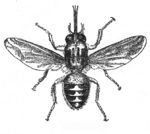Difference between revisions of "Glossinidae"
Jump to navigation
Jump to search
| Line 4: | Line 4: | ||
|- | |- | ||
|} | |} | ||
| + | |||
| + | The only genus in the family ''Glossinidae'' is ''Glossina'', more commonly known as TseTse flies. They are solely found in sub-Sahara Africa, and feed on the blood of vertebrates. | ||
[[Image:Glossinidae.jpg|150px|thumb|right|'''Glossinidae (Image sourced from Abb. aus Meyers Lexikon, Wikimedia Commons) ''']] | [[Image:Glossinidae.jpg|150px|thumb|right|'''Glossinidae (Image sourced from Abb. aus Meyers Lexikon, Wikimedia Commons) ''']] | ||
| − | + | ==Scientific Classification== | |
| + | {| cellpadding="10" cellspacing="0" border="1" | ||
| + | | Kingdom | ||
| + | | Animalia | ||
| + | |- | ||
| + | | Phylum | ||
| + | | Arthropoda | ||
| + | |- | ||
| + | | Class | ||
| + | | Insecta | ||
| + | |- | ||
| + | | Order | ||
| + | | Diptera | ||
| + | |- | ||
| + | | Superfamily | ||
| + | | Hippoboscoidea | ||
| + | |- | ||
| + | | Family | ||
| + | | Glossinidae | ||
| + | |- | ||
| + | | Genus | ||
| + | | Glossina | ||
| + | |} | ||
| − | + | ==Identification== | |
*6-13mm long | *6-13mm long | ||
Revision as of 12:14, 16 July 2010
| Also known as: | TseTse flies |
The only genus in the family Glossinidae is Glossina, more commonly known as TseTse flies. They are solely found in sub-Sahara Africa, and feed on the blood of vertebrates.
Scientific Classification
| Kingdom | Animalia |
| Phylum | Arthropoda |
| Class | Insecta |
| Order | Diptera |
| Superfamily | Hippoboscoidea |
| Family | Glossinidae |
| Genus | Glossina |
Identification
- 6-13mm long
- Prominent forward pointing proboscis
- Green thorax
- Yellow/brown abdomen
- Specific wing venation
- Closed cell 'butchers cleaver' shape
Life cycle
- Single larvae laid in shrubs
- Larvae wriggles into the soil to pupate
- Adult fly emerges 1 month later
- Life cycle take 2 months to complete
Pathogenesis
- Painful, irritating bites
- Both males and females suck blood
- Transmit trypanosomes
- Cause 'nagana' (wasting) disease in cattle and 'sleeping sickness' in humans
Control
- Scrub clearance to remove resting sites
- Ground and aerial spraying with insecticides
- Localised eradication using baited traps
- Dark coloured cloth
- Synthetic cattle urine
- Insecticide
- Sterile male insect release
